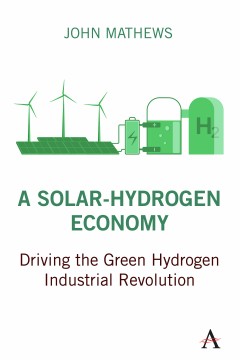A Solar-Hydrogen Economy
Driving the Green Hydrogen Industrial Revolution
By John Mathews
- About This Book
- Reviews
- Author Information
- Series
- Table of Contents
- Links
- Podcasts
About This Book
Guiding the emergence of a new green economy, based on a green industrial system and on green growth for its propagation, is the core challenge of our time. Efforts so far to switch to renewables in power generation have succeeded in partially transforming energy systems. Efforts to capture the process through imposition of carbon taxes or emissions trading schemes have fallen far short: these are policies based on simplistic comparative static economic frameworks involving changing prices but never engaging with the dynamic industrial drivers of change. A systemic perspective, focusing on the supersession of one technoeconomic system, based on fossil fuels, by another system, based on hydrogen, renewables and circular flows, is called for. The argument is developed that a new politics of energy is evolving from one based on fossil fuels to one where our industrial civilization is maturing and sees the manufacture of energy and energy devices as central to its continued survival.
In this book I construct an image of the green industrial revolution drawn from perspectives that are under-appreciated in conventional economics. Economic progress is viewed in terms of capture of increasing returns generated by manufacturing, with learning curves reducing costs as the market expands, in successive waves of circular and cumulative causation. Secondly, technoeconomic change is viewed as creative destruction, whereby competitive dynamics drive economic progress. And third, the economy is viewed as clusters of value chains replacing each other in a chain reaction of interactions propagating new chains and their interlinkages and eliminating incumbent chains. These perspectives, drawn from heterodox economics framed in disequilibrium, supplemented by a view of the emergence and diffusion of green hydrogen as a novel (sixth) technoeconomic paradigm surge, enable us to make sense of the dynamic green transformation emerging out of the matrix of the black fossil fuel system, where it is the future of our industrial civilization that is at stake.
Reviews
The book offers a nice and very compact introduction to a technoeconomic system likely to be an important component of a future global economic system. —Journal of Evolutionary Economics
“An impressive picture of a world fuelled by green hydrogen (made by solar power from water) for steel, cement, aluminium, chemicals, ammonia for fertilizers and hydrogen fuel cells for all transport. Could it help us escape global warming in time? Read on. It’s fascinating!” – Carlota Perez, Honorary Professor at IIPP-UCL and at SPRU, University of Sussex, Author of Technological Revolutions and Financial Capital: The Dynamics of Bubbles and Golden Ages.
Professor John Mathews has done the maths and his newest book, A Solar-Hydrogen Economy: Driving the Green Hydrogen Industrial Revolution, shows green hydrogen has the capability to completely replace the global, 12-billion tonne, fossil fuel-driven energy system — The Lighthouse.
Author Information
John Mathews is emeritus professor at Macquarie University, Sydney, tenable in the Macquarie Business School. He is the author of Global Green Shift (Anthem Press 2017) and of a blog on greening issues at: www.globalgreenshift.org. He was awarded the Schumpeter Prize in 2018 for his work on green industrial dynamics.
Series
Strategies for Sustainable Development Series
Table of Contents
Abstract; Analytical Contents; Acronyms; Acknowledgements; 1.Introduction; 2 A Solar-Hydrogen Economy; 3 Multiple Green Hydrogen Pathways; 4 A Green Growth Economy; 5 Perspectives from the Future: Twilight of Fossil Fuels; Bibliography; Index
Links
Stay Updated
Information
Latest Tweets



